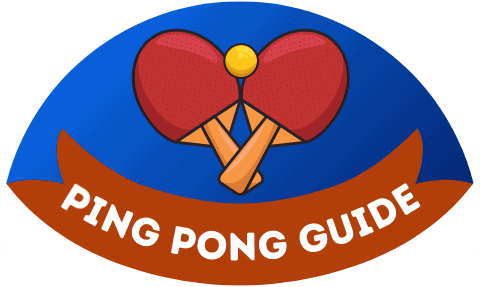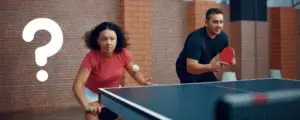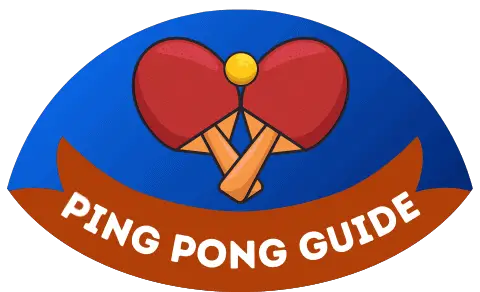You want to play table tennis but nobody has time to play with you? Or are you just looking for ways to practice alone? You’ve come to the right place. In this post, you will learn 8 ways to have fun playing table tennis without anyone else.
There are several ways to play table tennis alone. For some, you need additional equipment, like catch nets, robots, return boards, or spin trainers. But you can also train your serve, improve your technique with shadow training or sharpen your accuracy with trick shots. If your own table allows it, the playback mode is also a good option.
I have played many hours by myself and know that you can also have a lot of fun playing table tennis this way and improve at the same time. My tip for this: If you don’t have an opponent then play against yourself and challenge yourself.
Here are 8 ways how to play alone with and without additional equipment (at least a paddle and ball should be available for all variations).
Let’s start with additional equipment…
1. Training with a return board
A return board is nothing else than a board against which you play and which returns the ball. This sounds simple at first. Return boards are mainly used for technique training.
This is because, in contrast to the playback mode (one side of the table folded up), it can produce much more realistic rallies. The available boards have a rubberized surface and can be mounted at different angles. So they are able to generate spin by themselves.
You can mount a return board to any table tennis table and also vary the distance a bit. There are different variants for different game situations. E.g. for topspin training.
The cost is between $150 and $300. You can find a selection of popular return boards here.
If this is too expensive for you, you can of course try to build your own return board with old wooden planks.
2. Training with table tennis robot
The word robot sounds so fancy, but meant is a simple ball machine that can serve you many balls in a row.
Of course, this is the ideal case for playing alone. You can perfectly train your own consistency or reactivity. A robot can perhaps even better play the balls that cause you problems.
The price varies extremely there are models $300 but also for $3000. The good? A popular basic robot, the IPONG Trainer Motion, is available for around $170. This also includes 80 training balls
In addition, I would recommend a catch net. On Megaspin you can get the IPONG Trainer Motion with a catch net for less than $200.
3. Fold up one side of the table – playback mode
Many table tennis tables allow you to fold up one of the sides. This is called playback position. You simply play against the other side like against a wall.
Unlike return boards, it is a bit more difficult to get the ball back on the board. Especially topspin balls tend to bounce off the opposite side in a higher arc.
I always found it practical that you can explore the effects of your own spin when playing against the set-up table: Topspin – the ball bounces far, Sidespin – the ball bounces away to the side, and Backspin – the ball bounces down faster.
My tip: If you don’t want to pick up the ball all the time and play it against the plate with high frequency, undercut balls are especially suitable for this.
4. Spin Trainer
A spin trainer is another way to train table tennis on your own. A ball is attached to a movable arm, which you attach to the end of the table.
This way all common stroke types can be trained. As with an “analog ball machine”, the ball keeps coming back. So you don’t need a big set of balls
With around $20 a Spin-Trainer is also comparatively cheap:
Click here to get to the Spin Trainer
Now to the ways how to play table tennis without additional equipment…
5. Serve training
The one stroke you can practice perfectly on your own without a ball machine and a “wall” on the opposite side is the serve. Now you have time to work out your variations.
For this, you don’t need any other equipment besides a racket, balls, and access to a table.
However, it is a good idea to work with a large set of training balls. This way you don’t always have to fetch the balls again.
In addition, a catch net would then be ideal so that the balls collect comfortably at the end of the table and you can concentrate even more on your serves:
Here are my recommendations:
6. Ping pong ball juggling
We all know the next way to play alone. Even in a normal match, I juggle the ball on my racket at every free opportunity.
Playing the ball up and down should not be a problem for most people. However, you can make it a challenge. Here are a few suggestions:
- Change sides after each racket contact: forehand <> backhand.
- Use two rackets, one on the right and one on the left, and play the ball alternately.
- Juggle the ball only on the edge of the racket
- Extend point 1 by the edge: forehand -> edge -> backhand
- Juggle the ball only on the handle of the racket
- Change the position after each contact, e.g: Normal stance <> behind the back
I could go on enumerating but you will quickly come up with your own ideas. It’s fun especially when you try to set your own goals and surpass them. The time will pass faster than you would like 😉
7. Shadow training
Shadow training is a very good way to work on the finer points of your technique. Similar to shadow boxing, it’s all about executing the different stroke techniques correctly.
Ideally, you should stand in front of a mirror with some space around you, take your racket in your hand, and practice forehand, backhand, topspin, backspin, etc.
At the same time, it is a good idea to have a comparison or a template. I can highly recommend Timo Boll’s videos for this. Here is an example:
The continuous repetition of the movements helps you to store the correct stroke movements in the muscle memory. You will see that after a few sessions you will improve your technique even in a match.
8. Trick shots
What do I mean by trick shots? Have you ever tried to throw a paper ball into the trash can? And when you have done it, you stand somewhere else and try again.
You can do the same with table tennis. Build small targets that you have to hit with your serve, forehand, backhand topspin, etc. This is not only fun but also trains your precision.
Targets could be
- Cups
- First place them horizontally with the opening facing you on the other side of the plate.
- Pyramids from cups or cans
- Try to clear the pyramid completely, just like throwing cans.
- Candles
- Place a stable candle at the other end of the plate. Try to put it out with the ball.
If you love such challenges like me, the time will pass faster than you like. You can find good inspiration for trick shots to try yourself on the YouTube channel of the guys from Pongfinity.
How to find a table tennis partner?
If you’ve just been looking for ways to play table tennis alone because no one has time to play with you, here’s another little tip on how you might find new people for exciting matches.
I was in the situation myself and found table tennis players in my area via the app Spontacts. Unfortunately, this app is only available in Germany.
But I found that there are also many table tennis groups on meetup. So it’s definitely worth looking into that.
What equipment do I need to play table tennis alone?
You always need a bat and a ball. Additional equipment offers even more possibilities. At the end of this article, here is a small overview of what equipment is useful to play table tennis alone:
- Table tennis table with playback mode (one side folded up)
- A large set of training balls
- Catch net
- Table tennis robot
- Spin trainer
- Return board





